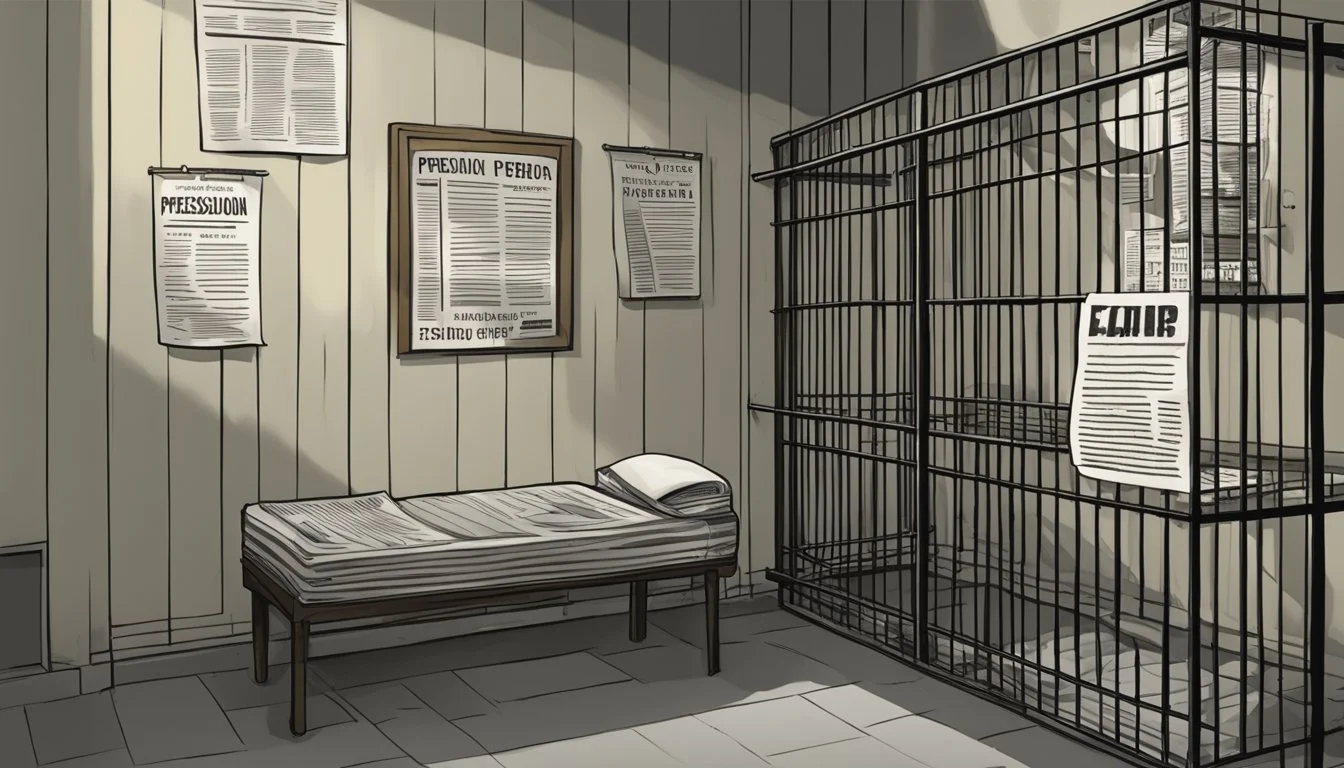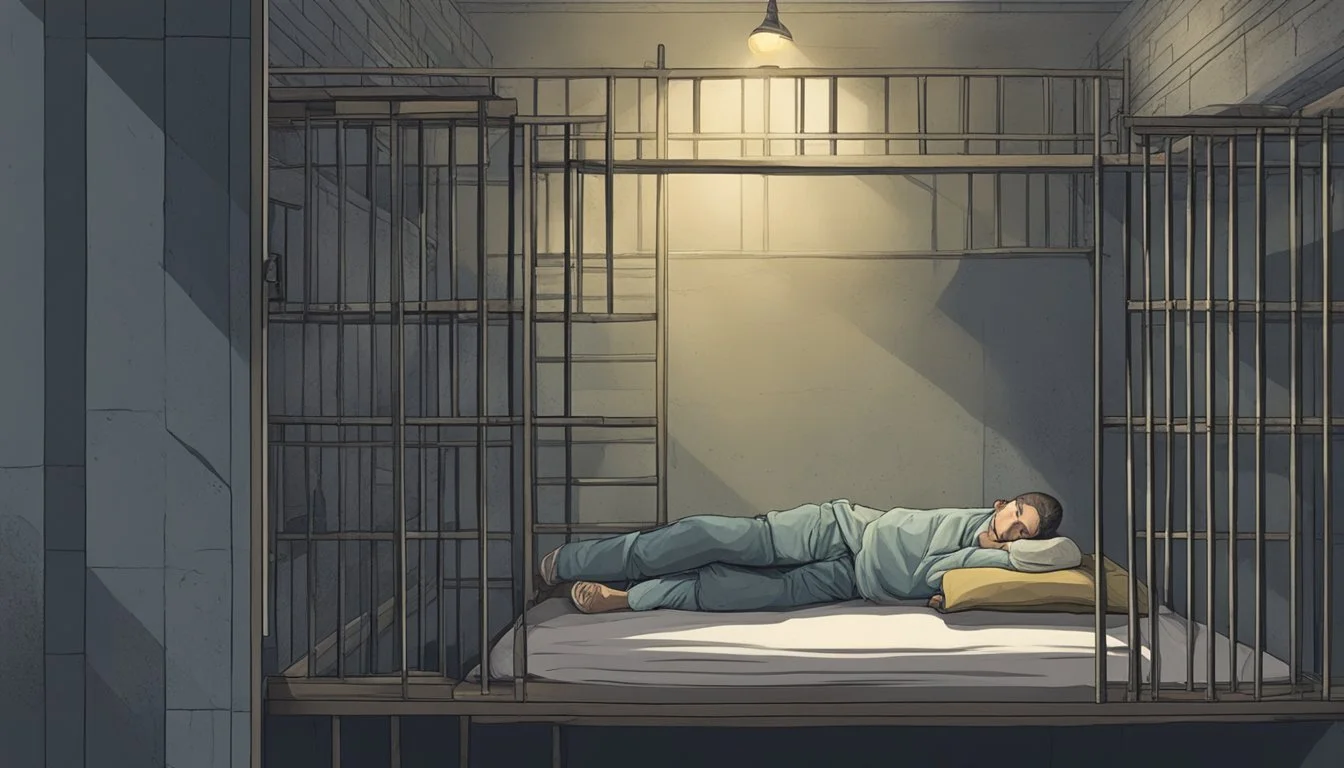Is Larry Bright, Peoria's Predator, Still Alive in Prison?
Latest Update on Serial Killer's Status
Larry Bright, known as Peoria's Predator, terrorized central Illinois with a series of brutal murders between 2003 and 2004. This American serial killer targeted women in Peoria and Tazewell Counties, leaving a trail of fear and destruction in his wake.
Larry Bright is still alive and serving a life sentence without the possibility of parole in an Illinois state prison. His reign of terror came to an end in 2006 when he pleaded guilty to eight counts of first-degree murder. Judge James Shadid handed down the life sentence, ensuring Bright would never again pose a threat to society.
The case of Larry Bright shocked the Peoria community and transformed several neighborhoods. His actions led to increased police presence and altered the daily routines of many residents, especially women. The impact of his crimes continues to resonate in the area, serving as a grim reminder of the darkness that can lurk within seemingly ordinary individuals.
Profile of Larry Bright
Larry Dean Bright, known as "The Bonecrusher," was an American serial killer who murdered at least eight women in central Illinois between 2003 and 2004. His crimes shocked the Peoria area and left a lasting impact on the community.
Early Life and Background
Larry Bright was born on July 8, 1966. He grew up in Peoria, Illinois, where he would later commit his heinous crimes. Details about his childhood and family life are limited in public records. Bright held various jobs throughout his adult life, including working as a concrete worker.
His early years did not immediately indicate the violent tendencies that would later emerge. Neighbors and acquaintances described him as relatively unremarkable, which made his later actions all the more shocking to those who knew him.
Criminal Records and Previous Offenses
Prior to his murder spree, Bright had encounters with law enforcement. His criminal record included minor offenses and drug-related charges. These early brushes with the law hinted at underlying issues but did not foreshadow the severity of his future crimes.
Bright's criminal activities escalated dramatically between July 2003 and October 2004. During this period, he targeted and killed at least eight women aged 30 to 41 in Peoria and Tazewell Counties. His victims were often associated with drug use or sex work, making them vulnerable targets.
Psychological Profile
Bright's psychological makeup remains a subject of interest for criminologists and mental health professionals. His behavior exhibited traits common among serial killers, including a lack of empathy and a desire for control over his victims.
Substance abuse played a significant role in Bright's life and crimes. He struggled with drug addiction, which may have contributed to his violent tendencies. This combination of psychological issues and substance abuse created a dangerous cocktail that fueled his murderous actions.
Bright's modus operandi involved burning his victims' bodies, earning him the gruesome nickname "The Bonecrusher." This ritualistic behavior suggests deep-seated psychological disturbances and a possible attempt to destroy evidence.
Crimes Committed
Larry Bright terrorized Peoria and Tazewell Counties in Illinois with a series of brutal murders targeting vulnerable women. His killing spree lasted from 2003 to 2004, leaving a trail of devastation in its wake.
Victims and Their Stories
Bright's victims were predominantly African American women involved in sex work or struggling with drug addiction. Among those murdered were Barbara Williams and Sabrina Payne. These women led challenging lives, often marginalized by society. Many had families and loved ones who continue to mourn their loss years later.
The victims ranged in age from 30 to 41. Their backgrounds and circumstances made them particularly vulnerable to Bright's predatory behavior. Some had turned to prostitution to support drug habits, while others were simply trying to survive in difficult circumstances.
The Killing Spree Timeline
Bright's reign of terror began in July 2003 and continued until late 2004. Over this 15-month period, he claimed at least eight lives. The murders occurred in rapid succession, with little time between killings.
Law enforcement struggled to connect the dots initially, as the victims' bodies were not always discovered immediately. The timeline of Bright's crimes:
July 2003: First known murder
October 2004: Final known victim killed
December 2004: Bright arrested
Murder Techniques and Modus Operandi
Bright earned the nickname "The Bonecrusher" due to his gruesome method of disposing of victims' bodies. He would often burn the remains in an attempt to destroy evidence. This made identification challenging for investigators.
His modus operandi typically involved:
Targeting vulnerable women involved in sex work
Luring victims to isolated locations
Murdering them through various means
Burning or otherwise mutilating the bodies
Bright's crimes were premeditated and showed a pattern of escalating violence. He took steps to conceal his actions, demonstrating a calculated approach to his killing spree.
Investigation and Arrest
The investigation into Larry Bright's crimes involved extensive forensic work and collaboration between multiple law enforcement agencies in central Illinois. Key breakthroughs led to Bright's capture and subsequent charges for multiple murders.
Forensic Evidence and Breakthroughs
DNA analysis played a crucial role in linking Bright to the victims. Forensic experts meticulously examined physical evidence from crime scenes and victims' bodies. They identified a distinctive pattern in the disposal of remains.
Soil samples from burial sites matched Bright's property. Trace evidence found on victims corresponded to materials in his possession. These forensic connections provided investigators with vital leads.
The Role of Local Law Enforcement
Peoria County Sheriff's Office led the investigation, working closely with Tazewell County authorities. Detectives conducted extensive interviews with witnesses and associates of the victims. They compiled a detailed timeline of disappearances and discoveries.
Law enforcement agencies shared information and resources to track the serial killer. They established a task force to coordinate efforts across jurisdictions. This collaboration proved essential in piecing together the complex case.
Capture and Charges
In December 2004, police arrested Bright for vehicular burglary. During questioning, inconsistencies in his statements raised suspicions. Investigators obtained a search warrant for his property.
The search uncovered crucial evidence linking Bright to the murders. Authorities charged him with multiple counts of first-degree murder. Prosecutors built a strong case based on forensic evidence and witness testimonies.
Bright ultimately pleaded guilty to eight murders in 2006. The plea deal spared him the death penalty but resulted in a life sentence without parole.
Trial and Conviction
Larry Bright's legal proceedings culminated in a guilty plea and life sentence. The court case brought closure for victims' families while sparing them a lengthy trial.
Court Proceedings
Prosecutors built a strong case against Larry Bright for the murders of eight women in Peoria, Illinois. Evidence included DNA matches and Bright's own confessions. The Peoria County State's Attorney's office prepared for a potential death penalty trial. However, plea negotiations began as both sides sought to avoid a prolonged court battle.
Guilty Plea and Sentencing
In 2006, Larry Bright pleaded guilty to eight counts of first-degree murder. This plea deal removed the possibility of the death penalty. Judge James Shadid sentenced Bright to life in prison without the possibility of parole. The agreement ensured Bright would never be free again while providing a swift resolution to the case.
Impact on the Victims' Families
The guilty plea spared the victims' families from enduring a lengthy, traumatic trial. Many expressed relief at avoiding graphic details in court. Some family members gave impact statements, describing their loss and pain. The life sentence provided a measure of justice, though it could not erase their suffering. Support groups formed to help families cope with their grief long-term.
Incarceration and Current Status
Larry Bright is serving a life sentence without the possibility of parole for his crimes. He resides in an Illinois state prison, where he has been since his conviction in 2006.
Prison Life
Bright is incarcerated at Shawnee Correctional Center in Vienna, Illinois. This medium-security facility houses approximately 1,700 inmates. Daily routines include meals, work assignments, and limited recreational activities.
Inmates at Shawnee have access to educational programs and vocational training. However, as a high-profile offender, Bright likely faces additional security measures and restrictions.
Prison records indicate Bright has had few disciplinary issues during his time at Shawnee. He maintains a low profile among the general prison population.
Parole Possibilities and Legal Appeals
Larry Bright has no chance of parole due to his life sentence without the possibility of parole. This was part of his plea agreement in 2006.
He has not filed any significant appeals or legal challenges to his conviction or sentence. The terms of his plea deal severely limit his options for post-conviction relief.
Local news outlets in Peoria occasionally report on Bright's case, but there have been no major developments since his sentencing.
Health and Well-being
At 58 years old, Bright's health appears stable based on available information. Prison medical records are confidential, but no reports of serious illness have surfaced.
Mental health services are available to inmates at Shawnee Correctional Center. It's unknown if Bright participates in any counseling or treatment programs.
As he ages, Bright will likely require more medical care, a common issue for long-term inmates. The Illinois Department of Corrections provides necessary healthcare to all prisoners.
The Societal Impact of Larry Bright's Crimes
Larry Bright's murders shook Peoria and surrounding communities, leaving lasting effects on residents. His actions sparked intense media scrutiny, prompted community responses, and led to changes in how such cases are handled.
Media Coverage and Public Attention
Local news outlets extensively covered Larry Bright's case, bringing it to national attention. The media focused on the victims' backgrounds and the investigation's progress. This spotlight raised awareness about violence against vulnerable populations.
Some criticized sensationalized reporting that potentially glamorized the killer. Others praised journalists for keeping the public informed and pressuring law enforcement to solve the crimes.
The case highlighted issues of drug addiction and sex work in the area. It sparked debates on how to address these underlying societal problems that can leave individuals vulnerable to predators.
Community Response and Support Structures
Bright's crimes galvanized community action in Peoria. Residents organized vigils and memorials for the victims. Local organizations expanded outreach to at-risk individuals.
Support groups formed for families of the victims and others affected by the crimes. These groups provided emotional support and advocated for justice.
The case prompted discussions about improving safety in vulnerable neighborhoods. Community leaders worked with law enforcement to enhance crime prevention strategies.
Some residents reported increased fear and vigilance, especially among women. This led to greater demand for self-defense classes and personal safety devices.
Lessons Learned from the Case
Law enforcement agencies reviewed their procedures for handling missing persons reports, especially involving marginalized individuals. This led to faster responses and more thorough investigations in similar cases.
The murders exposed weaknesses in tracking potential serial killers across jurisdictions. As a result, agencies improved information sharing and coordination.
Prosecutors and lawmakers examined the possibility of drug-induced homicide charges in cases where dealers supply drugs that lead to overdose deaths. This aimed to hold more individuals accountable in drug-related fatalities.
The case underscored the importance of addressing root causes of vulnerability, such as addiction and poverty. It spurred investment in social services and rehabilitation programs.






